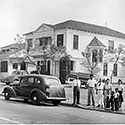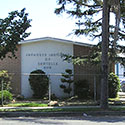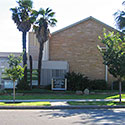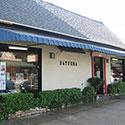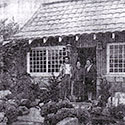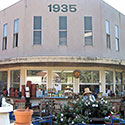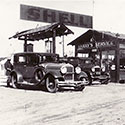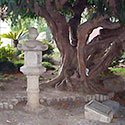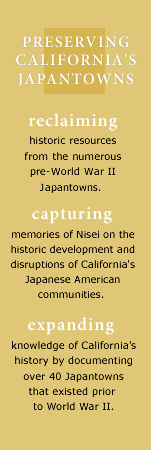 |
SawtelleClose proximity to the seashore that eased nostalgia for their homeland, the mild temperatures and rich soil ideal for working close to nature, and a cooperative network by the local Kenjinkai, were attributes attracting the early Issei to Sawtelle, or so-te-ru, in the 1910s. From 1920 to 1925, the town's population increased from 3,500 to 10,700, primarily due to the westward migration of the movie industry from New York, the influx of Nikkei farmers and merchants, and later the establishment of the University of California at Los Angeles (UCLA). With the growth of neighboring communities in Westwood, Bel Air, and Brentwood, the demand for Nikkei gardeners, nurserymen, and domestics increased; and the area became ideal for raising families. Becoming a part of greater Los Angeles and renamed West Los Angeles (WLA) in 1929, "Sawtelle"" still commonly refers to the commercial corridor of Japanese businesses and restaurants along Sawtelle Blvd, between Pico and Santa Monica Boulevards, and the residential neighborhood surrounding it. By 1941, Sawtelle boasted 26 nurseries/florist shops, 8 boarding houses, 8 gas stations/garages, 4 churches, 3 grocery stores, 5 shops, 4 barbers, 2 sewing schools, 1 beauty salon, and 1 Japanese language school and community hall. Today, only a handful of pre-World War II historic sites remain, but an influx of Japanese restaurants, markets, and the J-pop influence of the Giant Robot store and eatery provide a new identity, often referred to as "Little Osaka." ›› CLICK TO ENLARGE.
PROFILES
| ||||

Issei pioneer Riichi Ishioka purchased a city block on Sawtelle Blvd in the late 1920s and built Kobayakawa Boarding House into a successful enterprise. Mr. Ishioka offered a "gardeners' college," providing apprentice training and establishing gardening routes for his boarders. His wife Wakano operated the boarding house, preparing meals and obento lunch for the gardeners, and providing laundry and maid services. Kobayakawa Boarding House was comprised of several boarding houses, a parking lot, a mess hall, and apartment units, and housed up to 60 boarders at its height. By 1940, there were six boarding houses run by various families in WLA. Ishioka was one the first to re-open for business after the war, providing much needed shelter, comfort, and support for the returning Japanese Americans. Kobayakawa Boarding House continued to provide transition for post-war Japanese immigrants, and services expanded to include a dispatch service for established gardeners in need of day laborers or temporary workers. The business was closed in the mid-1970s; and the property was sold to developers who demolished the building to make way for one of the first multi-story office complexes in Sawtelle's Japantown.

Pacific Rose Company, operated by Kuichiro Nishi, settled its flourishing nursery business in WLA on 20 acres of property leased from the Veterans Administration at Wilshire and Sepulveda in the 1930s. From 1908, pioneer brothers Kuichiro Nishi and Akira Nishi had started their company by growing eight varieties of roses on seven acres of land in Pasadena. Shortly after in 1912, they moved to the Mid-Wilshire district of Los Angeles, opening both a nursery and flower shop. When the Ambassador Hotel was slated to be built on the site in 1918, Pacific Rose moved its operations to Hollywood and its flower growing to the San Fernando Valley, before finally moving operations to WLA.
After the bombing of Pearl Harbor, Kuichiro Nishi was immediately picked up the FBI, leaving his wife Hiro Nishi (called "Ma" by nursery workers) and older children to close up the business. With very little options, Mrs. Nishi chose to donate the $10,000 in plants and equipment to the Soldier's Home, rather than sell it for a fraction of its worth. The generous gesture was given full-page recognition in the Daily News on April 24, 1942. When K.H. Nishi & Son Nursery, a small bonsai nursery was opened after the war, Kuichiro Nishi continued to care for the plants he loved, but was never able to rebuild his enterprise. Click here to view a copy of the Daily News, Los Angeles, April 24, 1942. ››Click here to view the text of the Daily News, Los Angeles, April 24, 1942.

Early Issei pioneers started the first Japanese language class in the home of Gisuke Sakamoto in 1925. Inspired to educate their children in Japanese language and culture, the Issei pooled their resources; and by 1929, were able to dedicate the classroom building and incorporate as the Japanese Institute of Sawtelle. Sawtelle Gakuin, as it is commonly referred to, not only offered Japanese classes on a daily basis after public school or on Saturdays, but also became the social hub of Japanese cultural and community activity, uniting members of both the Buddhist and Christian churches.
The auditorium or community hall, built in 1940, was watched over by the American Red Cross during the war, and served as a hostel for returning Japanese Americans after World War II. The facility was remodeled to include a small kitchen in 1964, and renovated again in 1978 to its present configuration. After over 80 years, the Japanese Institute of Sawtelle continues to offer Japanese language classes on weekdays and weekends, and host speech contests and undokai (sports day) annually. The WLA Japanese American Community Center, an entity established in 1986 to coordinate the community activities, provides dojo space for three martial arts groups, coordinates a senior lunch program, facilitates health and wellness classes, and offers cultural arts classes.

In 1926, the Hashimoto brothers opened OK Nursery, located on the northwest corner of Sawtelle Blvd and La Grange Ave. Before the outbreak of World War II, the two elder brothers, Masahiko and Shichiro, had returned to Japan with their families. The two younger brothers, Juro and Suehiko operated the business until they were incarcerated at Manzanar. During the war years, the Hashimotos hired helpers to operate the business. After the war, eldest brother Masahiko Hashimoto returned to the U.S. in 1950 to operate the renamed Hashimoto Nursery; and second brother Shichiro returned to join the business in 1961. (The younger brothers ventured out and purchased land in Pacoima to begin their own nursery in 1957.) Due to the building of the Westside YMCA in the 1970s, the Hashimoto's were forced to move the nursery to its current site at 1935 Sawtelle Blvd. Continuing as the oldest nursery in the Sawtelle area, Joe Hashimoto, Shiichiro's son, has expanded the business to include various landscaping, shade and hanging plants, for both wholesale and retail.
Other longtime Sawtelle area nurseries include F.K. Nursery, Yamaguchi Bonsai, and Harada Nursery (Patch of Green Nursery, a recent effort by Jerry Isono of Sunnyside Nursery family). In each of these pre-war businesses rebuilt after WWII forced relocation; the fruits of Issei labor can be found in the nurseries' transitions to their Nisei children, and often to Sansei grandchildren, who continue to run these flourishing establishments.

Through the vision of six Issei pioneers, the Japanese Community Church was established in 1930. In 1931, a commercial building was leased at 1700 Sawtelle Blvd to serve as its temporary home. The current site at 1913 Purdue Av, which was then comprised of a two-story dwelling, was purchased in 1936 to serve as both a parsonage and chapel. In 1940, the Westwood Community Methodist Church donated their social hall, which was moved to its present location and first served as a chapel (now the social hall) for the growing congregation. After the war, the church buildings became a hostel for nearly a dozen families. In 1957, the new sanctuary was consecrated and the first all-church bazaar was held. WLA United Methodist Church continues today to serve a multi-ethnic congregation with a vibrant Sunday School, youth, and young adult program, contemporary music and worship, Japanese speaking ministry, and a variety of community and family events.
Sawtelle Nikkei also built a Buddhist Church, Sawtelle Howa Kai, which was organized as a branch of the LA Hompa Hongwanji Buddhist Temple in 1926 I n 1950, the church became independent and was officially designated as the WLA Buddist Church, where it continues to serve the community today.. With worship, religious studies, an active Dharma School, teen and youth group, taiko and cultural arts.

At the back of Harry's Shell Service Station operated by Harry Koga, Tom Ikkanda opened his first shop, Ikkanda Automotive Repair in 1937. After opening up the hood of his first automobile, Tom Ikkanda had set his sites on becoming a car mechanic that would prove to become a promising career direction. His early clients from 20th Century Fox were influential in protesting his incarceration at Manzanar; and by November, 1942, he and his wife Dorothy were directed to leave camp and California for the duration of the war. Joining his in-laws in Reno, Tom found work as a car mechanic, then enlisted in the Navy and served as an airplane mechanic and test pilot until the end of the war.
After the war, Tom Ikkanda set up shop once again in several leased spaces on Sawtelle Blvd, before opening up his own place on Olympic Blvd, which remained in operation until 1988. With the growing demand for Japanese cars in the U.S., he leased nearby space to open International Parts, Inc., becoming an importer of Japanese auto parts in the 70s. On the property lot of his former shop, is a multi-storied office complex joining the row of commercial high-rises on Olympic Blvd.

In 1939, H. Kaizuka built the commercial space on the west side of Sawtelle Blvd, and opened Modern Dress Shop and Modern Beauty Salon operated by his wife. The Mitchell Sewing School was held in the back of the store. In 1956, Thomas Tomio Sakai, purchased the property from his sister, to open Satsuma Imports, a Japanese gift shop. At that time, the Sakai family lived behind the shop and leased the adjoining space to Toyo Fish Market. When current owners, Don and his wife Cindy Sakai, took over the business from his father, they eventually expanded its Japanese merchandise, using the entire space as a showcase and installing a Japanese garden in the back. As one of the last remaining Japanese American businesses, Satsuma Imports offers a broad selection of fine Japanese imports, from Arita dishware, noren, zabutons, yukatas and other specialty items for the home.

In the 1930s, Stoner Park was the center of recreation for the Japanese American community, with Sunday afternoon baseball games and swimming in the outdoor public pool. In 1932, the Sawtelle community's Japanese garden was designed, carefully sculpted, and dedicated by Issei gardeners to foster cross-cultural goodwill. A sign of commemoration states "Presented by the Japanese people of Sawtelle for the promotion of better understanding." In the 1950s, the Bay Cities Gardeners Association with direction by Koichi Kawana and support of local nurseries restored the community garden, nearly lost due to neglect during the war years. In 1994, one hundred cherry blossom trees were presented by the West Los Angeles Japanese American Community Center and planted by the Bay Cities Gardeners Association and volunteers.
The Bay City Gardeners Association, started in 1955, had nearly 600 members at its onset primarily from Sawtelle and Santa Monica. They have continued to maintain the Stoner Park Community Garden, the WLA Buddhist Church garden, and host an annual orchid and bonsai show at Stoner Park, attracting over 1,000 attendees over a two-day period
